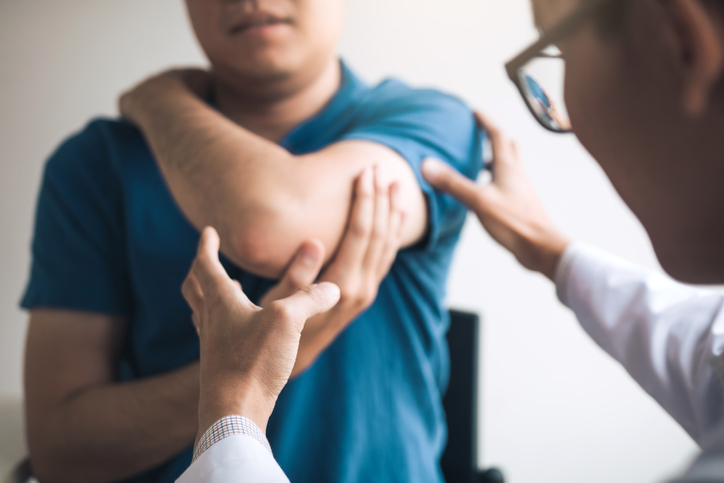Pain
Causes of Arm Pain
Source: Healthline, Everyday Health, National Institute of Neurological Disorders and Stroke: National Institutes of Health, National Institute of Neurological Disorders and Stroke: National Institutes of Health, Healthline, Arthritis Foundation, Healthline, Mayo Clinic, Healthline, Harvard Health, Mayo Clinic, Spine-health, Healthline, Johns Hopkins Medicine, Mayo Clinic, MedicineNet, National Center for Advancing Translational Sciences: Genetic and Rare Diseases Information Center: National Institutes of Health, WebMD

8 people found this helpful
Print
Share
Save
The causes of arm pain are numerous. This article focuses on causes of pain in the upper arm (humerus bone), lower arm (radius and ulna bones), elbow joint, and related muscles, ligaments and nerves.
Causes of arm pain include, but are not limited to, the following:
- Arthritis is an umbrella medical term used to refer to joint pain or joint disease. Several types of arthritis can affect the elbows, including rheumatoid arthritis, osteoarthritis, juvenile idiopathic arthritis, and psoriatic arthritis. Symptoms of rheumatoid arthritis in the elbow include joint pain, swelling and inflammation. Osteoarthritis of the elbow typically develops from overuse of the elbow joint. Juvenile idiopathic arthritis may also affect the elbow. Psoriatic arthritis can cause inflammation of tendons near the elbow, which causes pain.
- Angina occurs when the heart is not getting enough oxygen, but cell death is not occurring. Symptoms include left arm pain; shoulder, neck, jaw, or back discomfort; and a feeling of indigestion.
- Brachial plexus injury involves acute damage to the brachial plexus (a bundle of nerves that send signals from the spinal cord to the shoulder, arm and hand). A brachial plexus injury typically occurs as a result of trauma. Symptoms vary depending on the severity of the injury but may include numbness, weakness, severe pain, or paralysis in the affected arm.
- Carpal tunnel syndrome, also referred to as median nerve compression, develops from pressure or compression of the median nerve. The carpal tunnel is a narrow canal in the wrist through which the median nerve and tendons travel to connect the arm to the hand. Carpal tunnel syndrome occurs when the space or “tunnel” in the wrist is narrowed, putting pressure on the median nerve. Symptoms include pain in the hand, wrist or forearm, and numbness, tingling, and weakness in the fingers, hand or wrist.
- Cervical radiculopathy occurs when a nerve root in the cervical spine becomes inflamed or damaged. Symptoms of cervical radiculopathy include numbness, altered reflexes, weakness, and pain, which can radiate from the neck, down the shoulder, along the arm, and to the hand and fingers.
- Colles fracture, also referred to as a distal radius fracture, is a fracture of the lower end of the radius (a bone in the forearm), close to where it connects to the wrist. It is commonly referred to as a broken wrist. Symptoms include pain (especially when flexing the wrist), tenderness, swelling, bruising, or deformity of the wrist.
- Cubital tunnel syndrome, or ulnar neuropathy, involves compression on the ulnar nerve. The nerve passes close to the surface of the skin near the “funny bone.” Symptoms include pain or numbness in the elbow, pain in the wrist, numbness of the hand, tingling or weakness in the ring and pinky fingers, decreased grip strength, or muscle wasting of the hand.
- De Quervain's tenosynovitis is a painful condition that affects the tendons on the thumb side of the wrist. The exact cause is unknown, but it is associated with overuse of the wrist. Symptoms include pain or tenderness when rotating the wrist, grasping something, or making a fist. Pain may radiate up the arm, swelling may develop in the affected area of the wrist, and difficulty holding objects may occur.
- Dislocated elbow occurs when the bones that make up the elbow joint (radius, ulna and humerus) are forced out of alignment. Symptoms include extreme pain and obvious distortion of the joint.
- Elbow bursitis, or olecranon bursitis, involves inflammation of the bursa(e) in the elbow. Bursae are small sacs of fluid located throughout the body; they serve as cushions between bones and soft tissues (muscles, tendons and skin). Symptoms include stiffness, inflammation, pain (especially with movement or pressure), and a red and swollen appearance of the elbow.
- Gout is a complex form of arthritis that can develop when the blood contains high levels of uric acid. If the body produces too much uric acid or the kidneys excrete too little uric acid, it can build up in the blood and form sharp urate crystals in or around specific joints. Symptoms of gout in or around the elbow include pain, discomfort, tenderness, swelling, redness, warmth, stiffness, and limited range of motion.
- A humerus fracture is a fracture or break of the humerus bone (the bone in the upper arm). There are three types of fractures: proximal humerus fracture (which occurs near the shoulder), midshaft humerus fracture (which occurs in the middle of the bone), and distal humerus fracture (which occurs near the elbow). Typical symptoms include pain, swelling, bruising, arm deformity, or inability to move the shoulder or elbow.
- Myocardial infarction, commonly known as a heart attack, occurs when blood flow to the heart is blocked. Symptoms include feelings of pressure, tightness, pain, or a squeezing or aching sensation in the chest or arms that may spread to the shoulder, neck, jaw or back. Nausea, indigestion, heartburn, abdominal pain, shortness of breath, a cold sweat, fatigue, lightheadedness or dizziness may also occur.
- A rotator cuff tear can happen from an acute trauma/injury or degeneration due to aging. Depending on the cause of the tear, pain may not be felt immediately. However, a “snapping” sound or weakness in the upper arm may occur.
- Rotator cuff tendinitis is inflammation of the muscles and tendons in the shoulder. Tendons connect muscle to bone. Pain typically occurs with specific movements as the muscles rub against the inflamed tendons.
- A sprain occurs when ligaments are stretched or torn. Overextending the arm (e.g., engaging in a strenuous sport, landing awkwardly during a fall, lifting heavy objects, etc.) is the most common cause of sprains. Fortunately, most arm pain caused by a sprain is simple to treat with temperature therapy (applying ice packs) and pain medication.
- Tennis elbow, also known as lateral epicondylitis, is a condition which occurs when the tendons of the elbow become overstrained as a result of repetitive motions. Symptoms include aching pain in the elbow joint that may radiate into the forearm and wrist. Pain worsens when moving the elbow. Pain and weakness may make it difficult to perform everyday activities, such as shaking hands, gripping an object, turning a doorknob, or holding a cup of coffee.
- Thoracic outlet syndrome (TOS) occurs when nerves or blood vessels at the top of the thoracic outlet (a ring formed by the top ribs just below the clavicle) are compressed by the ribs, clavicle, or neck muscles. There are different types of TOS, depending on whether a nerve, vein or artery is the site of compression. Symptoms include neck, shoulder or arm pain, arm weakness, numbness of the fingers, and impaired circulation.
To learn more about the causes of wrist pain, please refer to Causes of Wrist Pain. To learn more about pain specific to the shoulder, please see Causes of Shoulder Pain. For more information on the anatomy of the arm, check out Healthline.com.






